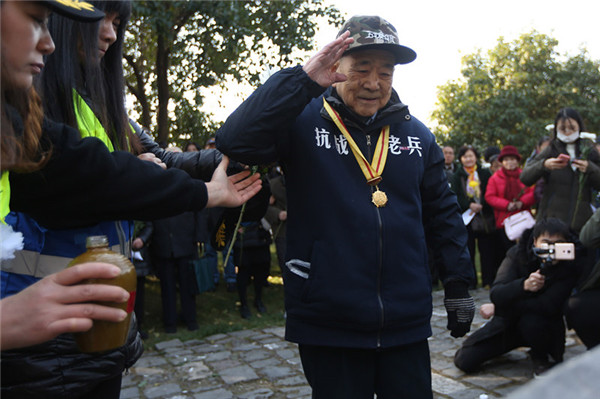
A Chinese veteran salutes the victims of the Nanjing Massacre. (Yang Bo/China News Service)
Xia's family tragedy-all of the women except her grandmother were raped before they were killed-was also recorded by the camera of John Magee (1884-1953), a US missionary who was in Nanjing during the massacre. After World War II, he testified against the Japanese at the Tokyo War Crimes Trials.
"When he heard what was happening, Magee rushed to the site, and using his 16 mm movie camera he didn't flinch from recording the most disturbing images," Wu said.
"The missionary was also the first person to hear Xia's story as the 8-year-old, who sustained three bayonet cuts, struggled to explain an atrocity she would only be able to grasp many years later."
In 1938, Magee's film, shot in secret on a number of occasions and lasting hundreds of minutes, was smuggled out of Nanjing to be developed in Shanghai. Before Magee left China in 1941, the film was taken out of the country by a friend.
"The footage Professor Gao showed me that fateful afternoon, he had brought back from a World War II archive in the US," Wu said.
"Despite a strict ban (on filming) by the Japanese, the images of cruelty leaked out, filmed both by foreigners and Chinese who owned cameras. They risked their lives to do so. "Another person Wu believes risked his life trying to expose the inhuman actions was known only as "C.S. Tai". "The name was on the cover of a book I bought in an antique market. It also appeared at the end of the book's English foreword, along with a date: 'Nov 8, 1938'," he said.
The book, which is typewritten, comprises two different works. One, called What War Means: The Japanese Terror in China, was written by Australian journalist Harold John Timperley (1898-1954); the other was by a US missionary, Lewis S.C. Smythe (1901-1978), and is called War Damage in the Nanking Area, December 1937 to March 1938. Both were penned in early 1938.
"Research shows that the books were not published in Nanjing, for obvious reasons. So this person, whose exact Chinese name we may never discover, typed the entire two books sitting in front of his typewriter in a room inside the Nanking Safety Zone," Wu said.
The zone, set up by a group of foreigners at the fall of Nanjing, provided a haven for many thousands of Chinese. It was operated by the International Committee, of which Magee was a member.
"Why would Tai do that? Because he wanted to expose the sin, and to offer hope to people locked in the 'city of death'," Wu said.
"In the final sentence of the foreword, he wrote: ' … I pray that our country will gain her final success, and become a strong country.' That kind of belief, when the fate of the city and its inhabitants seemed to have been sealed, is overpowering. I can almost hear the tapping sound his fingers made on the keys; solemn, emphatic, the soundtrack of a nation's struggle."


















































